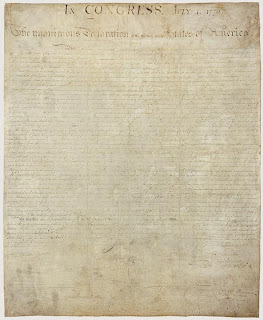I was reminded of that today and remembered having written a piece about the Declaration of Independence on this blog a few years back. I checked it and my source book: Signers of the Declaration: Historic Places Commemorating the Signing of the Declaration of Independence. This title is Volume XVIII in the series, The National Survey of Historic Sites and Buildings. The series editor was Robert G. Ferris. My copy is a revised edition, dated 1975, but it retains the Foreword written by Richard Nixon from the White House, Washington, D.C.

Sure enough, August 2nd was the day the document was actually signed. But not everyone who was supposed to sign actually did so. About fifty men showed up for the signing in Philadelphia on August 2nd, while another five signed later in the year. And one last straggler wrapped it up with his signature the following year--Thomas McKean from Delaware.Delaware may have been last in signing the Declaration, but in 1787 they were the first state to ratify the Constitution of the United States.
Here's what the original looks like. It's so worn and faded by time, it's hard to see the signatures, even when you click on the image to enlarge it.
Some interesting facts from the book:
- On July 4th, all colonies except New York voted to adopt the Declaration.
- The document was first read to the public on July 8th outside the Pennsylvania State House.
- New York approved the Declaration on July 15th. Four days later Congress ordered the document prepared on parchment for signature.
- The 56 signers did not sign as a group and did not do so on July 4th.
- The official signing took place on August 2nd, 1776. Fifty men signed at that time, five more signed later in the year, and one more the following year.
- On January 18th, 1777, Congress finally authorized the printing of the Declaration. Congress was worried about British retaliation against any and all who signed the Declaration, so they delayed having the signed document printed until after General Washington had claimed victories at Trenton and Princeton. Only one signature was missing at the time of this first printing: Thomas McKean from Delaware.
- Declaring one's independence is one thing, actually getting it is another. The fighting had begun before the Declaration and continued for seven years afterward. In the Treaty of Paris in 1783, Britain officially recognized the Americans' independence, which they had declared in 1776 and fought so hard for in the ensuing years.


No comments:
Post a Comment